STC Internal Clip filters: A Review
This is the written version of a pesentation I did for the Images Alberta Camera Club. I have included references to websites and other sources. All figures are my own work.
STC Clip Filters: A Review
By Ron Ross
Introduction
STC (Sense-Tech Innovation Company) of Taipei produces a wide variety of photographic filters, including specialist filters for underwater, infrared, and astrophotography. This includes filters that clip into the camera body, behind the lens and in front of the sensor. The design of the filter mount varies with camera brand. Olympus and Panasonic micro 4/3 cameras require different filter mounts, and they are not interchangeable. This review applies only to Clip Filters for Panasonic m43 cameras.
I purchased three Clip Filters for use in my full-spectrum Panasonic GX8: a 590nm IR pass, a 720nm IR pass, and an 850nm IR pass, plus a three-filter carrying case. When I had the camera converted, I had purchased a set of 62mm screw-in filters to fit my PL 12-60. They worked adequately, but there were five issues I hoped to solve with the Clip Filters.
-
I wanted to use all of my lenses. This would havee necessitated a slew of step up and down rings, and still left my 7-14mm zoom and my fisheye unusable as they have no filter threads.
-
The use of stepping rings often precluded the use of a lens hood. This is a major problem. Many lenses are prone to internal reflections in the infrared. I found that I had to be extremely aware of shooting angles, and even then had some issues with uneven contrast reduction.
-
The stepping rings limited my ability to use other filters and accessories.
-
Stepping rings made the camera/lens combo bulky and awkward. Square system filters such as Cokin or Lee would have helped other issues, but made this problem worse.
-
I was ending up with way too many filters, rings, etc. in my camera bag. Clip filters were a potential way to simplify my loadout.
Cost, Shipping and Service
Clip Filters are comparable in price to good quality screw-in filters from other suppliers. For example, the 850nm Clip Filter for Panasonic was $85US at the time of writing, while LifePixel charged $75US to $150US for front of lens filters, depending on filter size. Shipping was an extra $35US to Canada. I did get dinged an extra $20CDN by Canada Customs, but I consider that very reasonable given the overall size of the order.
The order was shipped promptly via DHL, and arrived in Edmonton in less than one week. Everything was packaged very securely and professionally. I didn’t require any post-purchase service, but was impressed with their service department anyway. They contacted me by e-mail before fulfilling my order, to make sure I knew that these filters would only work on a full spectrum camera. It was a nice touch, and shows that they are concerned with customer satisfaction.
Design and Build Quality
Each Clip Filter consists of a disk of optical glass firmly fixed in a stamped steel mount (Figures 1 and 2). The glass is claimed to have an anti-smudge and anti grease coating on both sides. I have been very careful when installing and removing the filters so haven’t tested the quality of this coating. The steel mount is A2/SAE 304 stainless (https://en.wikipedia.org/wiki/SAE_304_stainless_steel), with a hard matte black anti-reflection coating. The filter mounts by flexing very slightly, and so far everything is working well. I am not going to do metallurgical tests to verify the material, but my impression is that the mounts are very well made and are likely to be extremely durable.
Because the filter mounts between the lens and the sensor, any lens that extends deep into the camera body may cause issues. I would strongly recommend examining each of your lenses before first use to see if it have a long backwards extension, including racking zoom and focus to see if it causes a rearward extension. None of the lenses I own suffer from this problem, but my collection is far from complete!
As a side note, there are no pieces of padding glued to the mount. There was a thread on DPReview in which one owner of an Olympus Clip Filter complained that a rubber or felt pad had fallen off of his filter onto his sensor (https://www.dpreview.com/forums/post/63927861). No such pad exists on the Panasonic model filters.
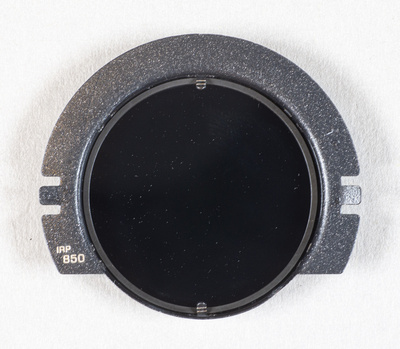 Fig 1 STC 850nm Filter Lens Side
Fig 1 STC 850nm Filter Lens Side
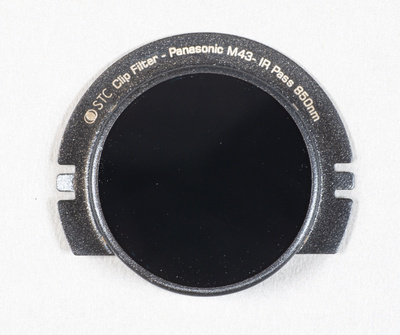 Fig 2 STC 850nm Filter Sensor Side
Fig 2 STC 850nm Filter Sensor Side
Handling
One of my main concerns when first looking at these filters was installation and removal. After all, this involves proximity to the sensor (Figures 3 and 4). STC has a Panasonic-specific video on their website (https://shop.stcoptics.com/product/clip-panasonicm43/), but I worried that the actor was someone with a lot of practice and/or especially small fingers. Once I tried it, I realized that installation and removal are easy if you follow their instructions. The only caveat is that for removal you need to hook a little tab (there is one on either side). If you have any sort of fingernail, you are set. However, if you are a guitar player, need to work with gloves, etc., you may need a small tool. I have a small plastic potter’s tool that does nicely, and will not scratch if I slip. It could also be used to set the filter if your fingers are too large.
Aside from that, it is worth noting that the filters are quite small. I strongly recommend changing filters where the camera can be laid on its back on a flat surface. Since changing the filter requires working with the lens off, it is also a good idea to work somewhere clean. Since I tend to only use one filter on an outing, this works well for me. If you want to change filters frequently in the field, screw mount or square system filters will probably suit you better.
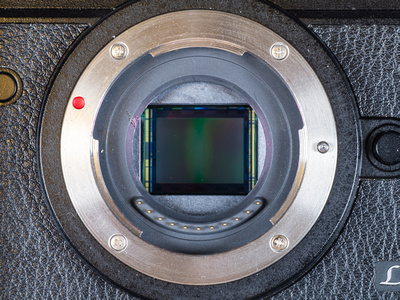 Fig 3 GX8 No Filter
Fig 3 GX8 No Filter
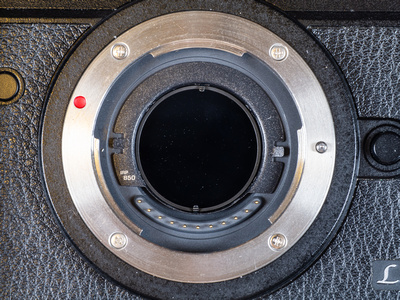 Fig 4 GX8 with Filter
Fig 4 GX8 with Filter
Hot Spots and Flare
One unexpected benefit of switching to the Clip Filters was the almost complete elimination of IR hotspots and flare. Anyone who has used an infrared or full spectrum digital camera is painfully aware that many lenses produce infrared hotspots (KolariVision https://kolarivision.com/articles/lens-hotspot-list/, LifePixel https://www.lifepixel.com/lens-considerations/lens-hot-spot-testing-database) at some or all focal lengths and apertures. For example, the Panasonic 14-140 MKII is known to be problematic from 14mm to about 25mm, resulting in the effect seen in Figure 5. This effect is most visible when using “standard” (720nm) and “black and white” (820-850nm) filters. In addition, many lenses are prone to internal flaring, as seen in Figure 6. These can often be “corrected” in post processing (Parapadakis 2015 https://4ground.wordpress.com/2015/01/09/how-to-fix-ir-hotspots/), but it adds an extra level of work and annoyance.
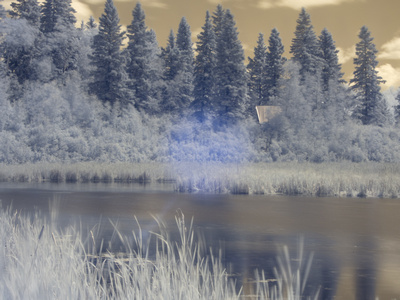 Fig 5 Hotspot
Fig 5 Hotspot
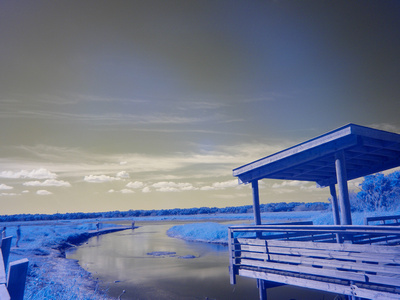 Fig 6 Lens Flare
Fig 6 Lens Flare
Before I got the Clip Filters, I tested each lens I owned, where I could mount a filter, for hot spots and flare. This involved shooting four series of images (towards the sun, 90 degrees left, 90 degrees right, 180 degrees) from wide open to fully stopped down with each filter. With zoom lenses I repeated this for all marked focal lengths. I repeated the test again with the Clip Filters, this time including lenses like the 7-14. So far I have not been able to reliably produce either flare or hotspots. I have seen a few very mild, very diffuse hotspots (about 8 in 2000+ exposures), but they have only been visible after application of vigorous contrast adjustments (contrast, clarity, texture, dehaze, tone curve) in post processing.
I can only speculate on why the Clip Filters reduced or eliminated these problems. With the flare, it may relate to being able to use lens hoods normally, and/or elimination of an uncoated glass surface in front of the lens. In other words, a coated filter may have helped.
IR hotspots are poorly understood, and may arise from multiple sources (Melentijevic 2018 https://kolarivision.com/the-science-of-infrared-hotspots/). One suggestion is that they are reflections of the sensor on the rear element of the lens. The Clip Filter’s position may disrupt such reflections. The reflection theory is supported by several lines of evidence:
-
Digital sensors are often highly reflective in IR but not visible light. Experiments with anti-reflection sensor coatings are reported by some authors to have helped.
-
Hotspots are worse at smaller apertures, just like sensor spots. This tends to implicate something close to the surface of the sensor.
-
The problem is not seen in film cameras. IR film is not reflective in IR.
In any case, the difference has been very noticeable, and very helpful. Whether this would be the case for other brands of cameras cannot be determined from my tests.
The Carrying Case
I ordered a carrying case with my Clip Filters, and am glad I did. The case is a stack of metal cylinders (probably aluminum) that screw together, with top and bottom rings that screws in (Figure 7 and 8). They are extremely well made, apparently specifically for the Panasonic filters, and provide a compact, secure, and elegant carrying solution.
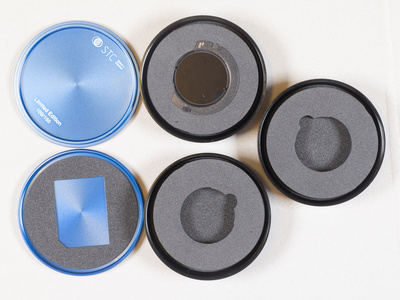 Fig 7 Filter Holder Opened
Fig 7 Filter Holder Opened
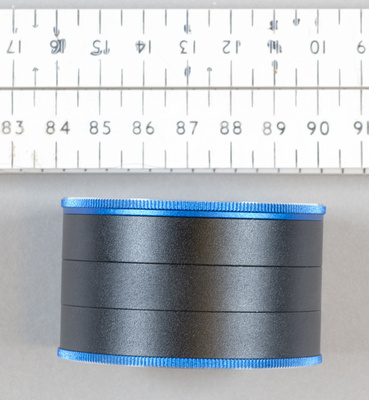 Fig 8 Filter Holder Closed
Fig 8 Filter Holder Closed
Conclusion
No one solution fits everyone. For me, the STC filters solved all the issues I had identified, and more. The reduction/elimination of the flare and hotspot problems has made creating infrared images a lot more about creativity and a lot less about solving technical issues.